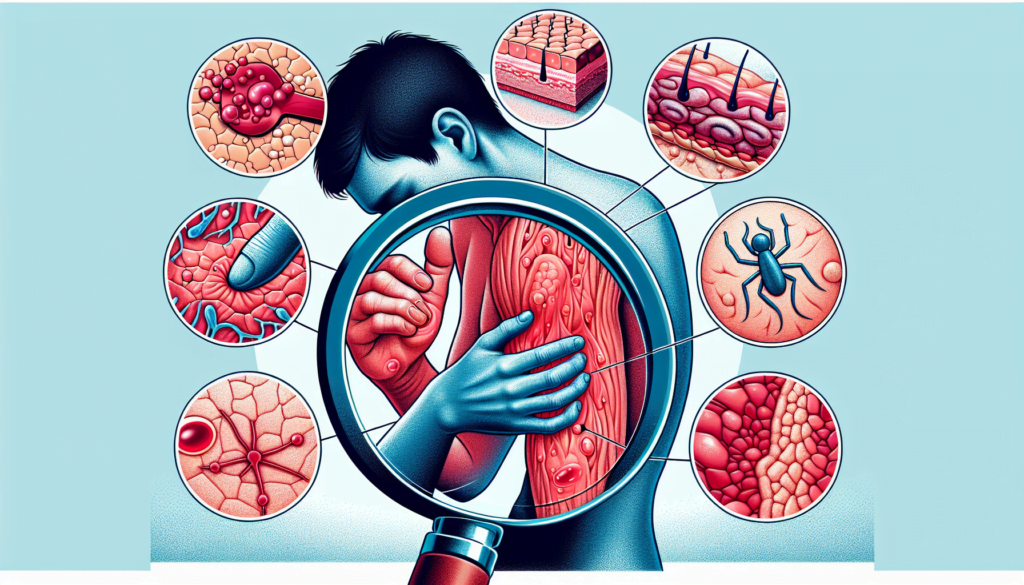Have you ever wondered about the hidden signs and symptoms of eczema that go beyond the surface? In this article, we will shed light on the often overlooked yet important aspect of the condition – internal eczema symptoms. While the external manifestations of eczema are well-known, it is crucial to recognize and understand the less visible indicators that can greatly impact one’s overall well-being. So, let’s explore these internal symptoms and gain a deeper understanding of eczema from the inside out.
Understanding Internal Eczema Symptoms
Eczema, also known as atopic dermatitis, is a skin condition that affects millions of people worldwide. While most people are familiar with the external symptoms of eczema, such as dry and itchy skin, it is important to recognize that eczema can also manifest internally. Internal eczema refers to the involvement of internal organs and systems, leading to a range of symptoms beyond just skin-related issues.

What is Internal Eczema?
Internal eczema, as the name suggests, involves the internal systems of the body. It is characterized by inflammation, itching, and other symptoms affecting various organs and tissues. While external eczema predominantly affects the skin, internal eczema can impact the digestive, respiratory, and musculoskeletal systems, among others.
Causes of Internal Eczema
The exact cause of internal eczema is still not fully understood. However, several factors have been identified as potential contributors:
Genetic Factors
There is a strong genetic predisposition to developing eczema. If you have a family history of eczema or other allergic conditions like asthma or hay fever, you may be more likely to develop internal eczema.
Immunological Factors
Internal eczema is closely linked to an overactive immune system. The immune system in individuals with eczema reacts excessively to certain triggers, leading to inflammation and other symptoms.
Environmental Factors
Exposure to certain environmental substances can exacerbate internal eczema symptoms. Examples include pollen, pet dander, dust mites, and mold. These allergens can trigger an immune response, worsening the symptoms of internal eczema.
Dietary Factors
Certain foods can act as triggers for individuals with internal eczema. Common culprits include dairy products, nuts, eggs, and gluten. Identifying and avoiding these triggers can help manage symptoms.
Stress and Psychological Factors
Stress is known to exacerbate eczema symptoms, both externally and internally. Emotional distress and anxiety can trigger flare-ups in individuals with internal eczema, making stress management an important aspect of treatment.
Common Triggers of Internal Eczema
Identifying triggers is crucial in managing internal eczema symptoms. Some common triggers include:
Food Allergies
Food allergies, such as dairy, eggs, wheat, and soy, can provoke internal eczema symptoms. Keeping a food diary and working with a healthcare professional can help identify and avoid these trigger foods.
Airborne Allergens
Pollen, pet dander, dust mites, and mold spores in the air can worsen internal eczema symptoms. Reducing exposure to these allergens by using air filters and regularly cleaning your living space can help alleviate symptoms.
Chemical Irritants
Certain chemicals found in detergents, soaps, and cleaning products can irritate the skin and aggravate internal eczema symptoms. Opting for fragrance-free and hypoallergenic products can minimize flare-ups.
Sweating and Heat
Sweating can exacerbate internal eczema symptoms due to the moisture and heat on the skin. Avoiding excessive sweating and maintaining a cool and dry environment can help manage symptoms.
Microbial Infections
Bacterial, fungal, and viral infections can trigger internal eczema flare-ups. These infections increase inflammation and compromise the skin’s barrier function. Proper hygiene practices and prompt treatment of any infections can help reduce symptoms.

Symptoms of Internal Eczema
Internal eczema presents with a range of symptoms that can vary from person to person. Some common symptoms include:
Itching and Irritation
Itching is a hallmark symptom of internal eczema. It can be intense and persistent, leading to constant scratching, which further exacerbates the condition.
Redness and Inflammation
The affected areas may become red and inflamed due to increased blood flow and immune response. This can contribute to a feeling of warmth and tenderness.
Dry and Scaly Skin
The skin affected by internal eczema may appear dry and flaky. It may feel rough and roughened due to the compromised moisture barrier.
Swelling and Edema
In some cases, internal eczema can cause swelling and fluid retention in the affected areas. This can lead to uncomfortable swelling and reduced mobility.
Blisters and Crust Formation
In severe cases, blisters may form, followed by the development of crusts. These skin lesions can be sore and prone to infection if not properly managed.
Thickened and Leathery Skin
In chronic cases of internal eczema, the skin may become thickened and leathery. This is known as lichenification and is a result of repeated scratching and inflammation.
Signs of Internal Eczema on the Skin
The skin can provide valuable visual clues to the presence of internal eczema. Some signs to look out for include:
Appearance of Rashes
Internal eczema often presents as a rash on the skin. These rashes can vary in color and texture, depending on the severity and duration of the condition.
Location and Distribution of Rashes
The rashes associated with internal eczema can occur in different areas of the body, including the face, neck, arms, legs, and torso. The rashes may be localized or spread across larger areas.
Color and Texture of Rashes
The rashes can range in color from red to brownish-gray. The texture can be dry, scaly, or blistered, depending on the underlying inflammation and severity of the condition.
Other Visible Skin Changes
In addition to rashes, the skin affected by internal eczema may show signs of dryness, cracking, and thickening. These changes are indicative of chronic inflammation and compromised skin barrier function.
Internal Symptoms of Eczema
Internal eczema can extend beyond the skin and affect various systems within the body. Some internal symptoms to be aware of include:
Digestive Issues
Internal eczema can cause gastrointestinal symptoms such as abdominal pain, diarrhea, and nausea. These symptoms may be triggered by certain foods or could represent an immune-mediated response.
Respiratory Problems
Internal eczema can impact the respiratory system, leading to symptoms such as coughing, wheezing, and shortness of breath. These symptoms can be worsened by environmental triggers or underlying allergies.
Joint Pain and Arthritis
In some cases, internal eczema can be associated with joint pain and inflammation, resembling symptoms of arthritis. This can impact mobility and quality of life.
Fatigue and Malaise
The chronic inflammation associated with internal eczema can lead to fatigue, general malaise, and a feeling of being unwell. These symptoms can further contribute to the psychological impact of the condition.
Sleep Disturbances
The itching and discomfort caused by internal eczema can significantly interfere with sleep. This can lead to increased fatigue, irritability, and decreased overall well-being.
Differences Between Internal and External Eczema
There are several key differences between internal and external eczema:
Affected Body Regions
External eczema primarily affects the skin, whereas internal eczema can involve multiple systems within the body, including the gastrointestinal and respiratory systems.
Manifestation of Symptoms
Internal eczema symptoms are not limited to the skin. In addition to skin-related symptoms, internal eczema can cause digestive issues, respiratory problems, joint pain, and other internal complications.
Treatment Approaches
While treatment for both internal and external eczema incorporates similar principles, managing internal eczema often requires a more comprehensive approach. This can involve addressing potential triggers, managing internal symptoms, and considering specific medications to target internal inflammation.
Complications and Risks Associated with Internal Eczema
Internal eczema can lead to various complications and risks. Some of the common ones include:
Infection and Secondary Skin Conditions
The compromised skin barrier in individuals with internal eczema can increase the risk of skin infections caused by bacteria, fungi, or viruses. It can also lead to the development of other skin conditions such as cellulitis or eczema herpeticum, which require prompt medical attention.
Psychological Impact and Emotional Distress
Living with a chronic condition like internal eczema can take a toll on a person’s mental health. The constant discomfort, visible skin changes, and impact on daily activities can lead to anxiety, depression, and decreased self-esteem.
Impaired Quality of Life
The presence of internal eczema and its associated symptoms can significantly impact an individual’s quality of life. The itching, pain, and other physical symptoms can limit daily activities, impair sleep, and interfere with social interactions and general well-being.
Diagnosis of Internal Eczema
Diagnosing internal eczema involves a comprehensive evaluation of symptoms, medical history, and physical examination. In some cases, further tests may be necessary to assess the involvement of internal organs and to rule out other conditions with similar symptoms.
Treatment Options for Internal Eczema
The management of internal eczema requires a multi-faceted approach tailored to each individual’s specific needs. Some treatment options to consider include:
Lifestyle and Self-care Measures
Maintaining good skin hygiene, avoiding triggers, managing stress, and sticking to a healthy diet can all help manage internal eczema symptoms.
Topical Medications
Topical corticosteroids and moisturizers can be prescribed to reduce inflammation and restore the skin’s barrier function.
Oral Medications
In more severe cases, oral medications such as antihistamines, immunosuppressants, or corticosteroids may be prescribed to target the internal inflammation associated with eczema.
Phototherapy
Phototherapy or light therapy involves exposing the skin to specific wavelengths of light to reduce inflammation and promote healing. This can be an effective treatment option for internal eczema.
Biologic Therapies
Biologic therapies are a newer class of medications that target specific immune pathways involved in eczema. These medications can help manage internal inflammation and improve symptoms.
Alternative and Complementary Approaches
Some individuals find relief from internal eczema symptoms through alternative and complementary approaches such as acupuncture, herbal remedies, and relaxation techniques. However, it is important to consult with a healthcare professional before incorporating these approaches into your treatment plan.
In conclusion, understanding internal eczema symptoms is crucial for effective management and treatment. By recognizing the signs, identifying triggers, and adopting a comprehensive approach to care, individuals with internal eczema can find relief and improve their quality of life. Remember to consult with a healthcare professional for a personalized diagnosis and treatment plan suited to your specific needs.


